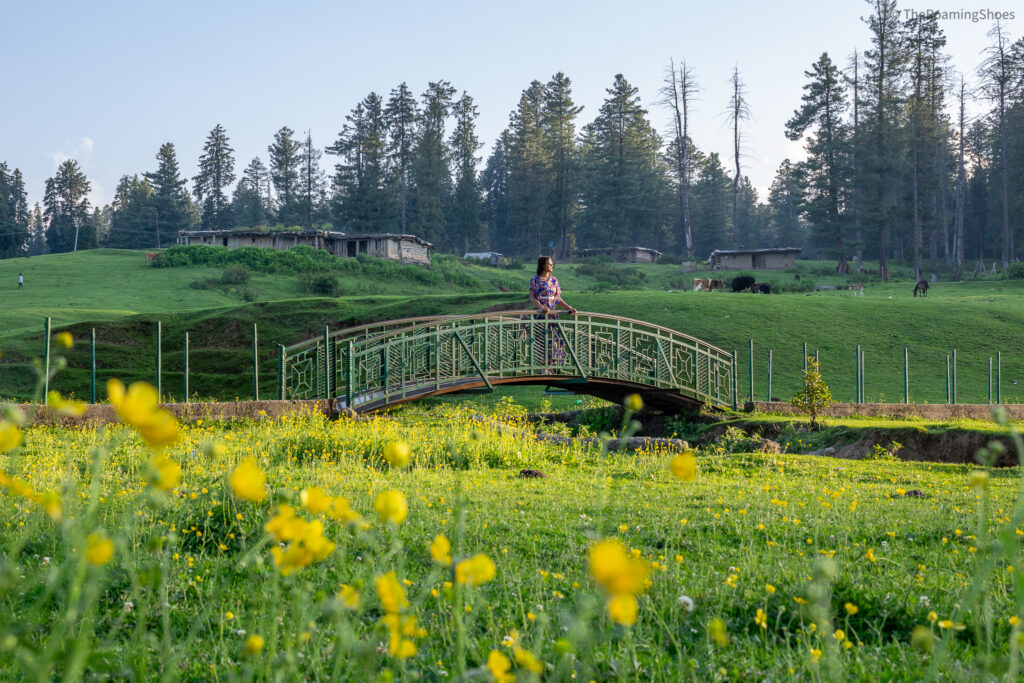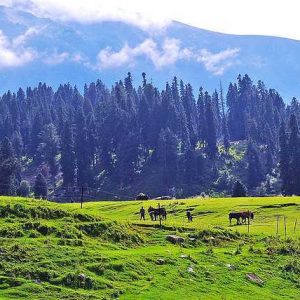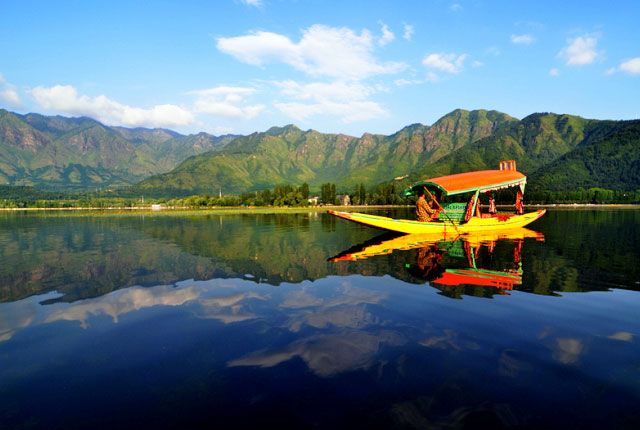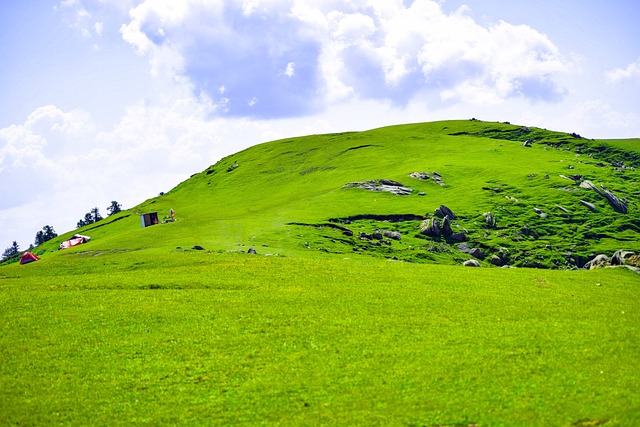
Best Time to Visit Yousmarg
Table of Contents
ToggleOverview
Nestled in the heart of the Pir Panjal range, Yousmarg in Kashmir is a hidden gem that promises pristine meadows, snow-capped peaks, and an unspoiled natural charm. Whether you’re planning a romantic getaway, an adventurous trek, or simply a peaceful retreat, knowing the best time to visit Yousmarg can make all the difference. In this detailed Yousmarg travel guide, we will take you through the best time to visit Yousmarg, climate factors, month-wise details, and tips from the inside to plan your perfect itinerary.





Reasons Why Yousmarg Must Be in Your Kashmir Travel Plan
Yousmarg, often referred to as the “little meadow” of Kashmir, is less crowded than the more famous Gulmarg, offering an authentic experience of alpine wilderness. You’ll find rolling green pastures dotted with wildflowers in summer and endless white vistas in winter—perfect for families, solo travelers, and honeymooners alike. If you’re scouting for Instagram-worthy locations, Yousmarg trekking routes, or want to chase snowfall in Kashmir, this is the place that ticks all the boxes.
Learning About Yousmarg’s Climate and Weather Patterns
To make a decision regarding the most appropriate time to visit Yousmarg, it is important to know the climate of the area:
- Spring (March – May): While the snow melts, colorful wildflowers cover the meadows. Temperatures during the day vary from 7°C to 18°C, and spring is a great season for photography and easy trekking.
- Summer (June – August): Mild temperatures of 12°C to 22°C attract tourists fleeing the heat of India’s plains. The scenery becomes lush green and streams overflow with glacial melt—ideal for picnics and camping.
- Monsoon (July – September): Though rains bring landslides in certain areas of Kashmir, Yousmarg’s elevation (about 2,400 meters) keeps heavy showers in check. Intermittent showers are on the cards; best for those looking for solitude and fewer tourists.
- Autumn (October – November): Post-monsoon clarity reveals breathtaking views of the Zanskar and Harmukh ranges. Day temperatures are around 10°C–16°C, with fresh air perfect for trekking.
- Winter (December – February): A thick layer of snow turns Yousmarg into a winter wonderland. Temperatures range to –5°C or below, making it a hot destination for Yousmarg snow activity such as sledding and snowshoeing.
Ideal Timeframes by Season
Spring Splendor (Late March – Mid May)
Spring in Yousmarg is characterized by initial thaws of snow and the carpeting of alpine flowers. This season is usually touted as the ideal time to visit Yousmarg for wildlife lovers and photographers.
Highlights: Tulip meadows, gushing streams, migratory birds.
Activities: Nature walks, bird watching, easy treks to Nilnag Lake.
Tips: Wear layers—morning and evening can be cold even on sunny days.
Summer Escape (June – August)
Summer brings with it the tourism peak season in Kashmir. Yousmarg’s pleasant weather—hardly ever crossing 22°C—is a welcome break from the hot plains. Family tours and independent travelers love this season.
Highlights: Green fields, glacial streams, horse rides.
Activities: Night camping beneath starry skies, pony rides to Doodh Ganga River, overnight trails.
Tips: Reserve your homestays and campsites early, as domestic capacity gets occupied fast.
Monsoon Magic (July – September)
While monsoon prevails over most of India with copious rain, Yousmarg is treated to moderate rains. Treks undertaken at this time treat you to epic cloudscapes and thunderous waterfalls.
Highlights: Cloud-shrouded landscapes, deserted trails, cascading torrents.
Activities: Photography, trekking to hidden waterfalls, offbeat trekking.
Tips: Pack waterproof equipment, verify road conditions from Srinagar prior to leave.
Autumn Aura (October – November)
Autumn has crystal clear skies and breathtaking views of the mountains. Thin crowds and pleasant weather make it an excellent season for Yousmarg trekking.
Highlights: Golden meadows, Himalayan panoramas, clear nights for star-gazing.
Activities: Day hikes, photo tours, visits to local villages.
Tips: Night temperatures may drop to below 5°C; bring a warm jacket.
Winter Wonderland (December – February)
If snow chasing is something on your checklist, winter in Yousmarg does not disappoint. The meadow becomes a snow playground, ideal for thrill-seekers.
Highlights: Snow-covered valleys, icicles on pine branches, ghostly white quiet.
Activities: Sledding, snowshoe treks, ice-climbing on frozen streams.
Tips: Pack snow boots, thermal clothing, and look out for weather advisories on snowfall intensity.
Month-by-Month Breakdown
March
Weather: 5°C–12°C, delayed snowmelt.
Experience: Ideal for early spring flowers, less crowd.
Weather: 7°C–15°C, clear skies.
Experience: Peak wildflower season, bird migration.
May
Weather: 10°C–18°C, sunny and mild.
Experience: Ideal for photography, easy walks.
June
Weather: 12°C–20°C, rich greenery.
Experience: Beginning of peak season, pony rides to Pine forests.
July
Weather: 14°C–22°C, occasional showers.
Experience: Fewer tourists, spectacular cloud cover.
August
Weather: 13°C–21°C, low humidity.
Experience: Ideal weather for camping, clean trails.
September
Weather: 12°C–19°C, freshness post-monsoon.
Experience: Clear mountain vistas, ideal for trekkers.
October
Weather: 10°C–16°C, fresh air.
Experience: Golden meadows, photographer’s paradise.
November
Weather: 5°C–12°C, early snowfall.
Experience: Peaceful scenery, ideal for writing or meditation retreats.
Weather: –2°C–5°C, heavy snowfall starts.
Experience: Sledding adventures, winter walks in scenic settings.
January
Weather: –5°C–2°C, maximum snowfall.
Experience: Winter sports, frozen lake hikes.
February
Weather: –3°C–4°C, slow thaw.
Experience: Fewer visitors, fresh snow sparkling in sunlight.
Seasonal Festivals and Activities
- Tulip and Spring Flower Festival: While Srinagar’s tulip festival is bigger, local meadows are colored with vibrant flowers in April and May, perfect for flower photography.
- Doodh Ganga River Rafting: Operates during summer months with expert guides, adding an adrenaline-packed spin to your Yousmarg travel guide.
- Winter Snow Carnival: Locals hold spontaneous snowman competitions and sled racing, treating travelers to a sample of Kashmiri hospitality.
- Local Village Fair (Mela): Shepherd villages surrounding the area host traditional music sessions and craft fairs in August—ideal for cultural immersions.
Accommodation and Booking Tips
Offbeat as it may seem, Yousmarg has plenty of stays available:
- Homestays: Live Kashmiri culture; home-cooked Wazwan meals provided by local hosts.
- Tented Camps: Seasonal tents with heating arrangements, in demand during summer.
- Cottages and Guesthouses: Mid-range establishments around the meadow periphery.
- Luxury Retreats: A few high-end resorts located just beyond the principal meadow.
Booking Tips:
- Advance Reservations: Book spring and summer at least 2–3 months in advance.
- Off-Season Offers: Winter and monsoon seasons tend to provide reduced prices.
- Check Cancellation Policies: Weather is uncertain; flexible schedules avert tension.
What to Bring for Your Yousmarg Tour
Packing the necessary equipment is key to a comfortable stay:
- Clothing Layers: Thermal undergarments, fleece pullovers, water-resistant outer layers.
- Footwear: Water-resistant trekking boots or rugged sneakers; snowshoes during winter.
- Accessories: Woollen caps, gloves, scarves, sunglasses to protect against glare from snow.
- Gear: Rain cover daypack, refillable water bottle, trekking poles.
- Electronics: Portable power bank, camera with spare batteries, smartphone with downloaded maps.
Where is Yousmarg and How to Get There
By Air:
The closest airport is Sheikh Ul Alam International Airport in Srinagar (about 45 km). There are frequent flights connecting Srinagar to Delhi, Mumbai, and other major Indian cities.
By Road:
Car/Taxi: A 2-hour picturesque drive from Srinagar through Magam and Charari Sharief.
Bus: Limited state buses run on fair-weather days; reservations through the Jammu & Kashmir Transport Corporation.
By Rail:
The closest railhead is Jammu Tawi (about 300 km), followed by road travel. Though longer, the train-and-road combination is a cost-effective alternative.
Local Delicacies to Try
No Yousmarg travel guide is complete without indulging in Kashmiri cuisine:
- Gushtaba: Mince mutton balls in yogurt sauce.
- Rogan Josh: Fragrant lamb curry.
- Kahwa: Classic saffron tea, ideal for cold mornings.
- Modur Pulav: Sweet rice with dry fruits.
- Lyodur Tschaman: Cottage cheese in yogurt sauce.
Most guesthouses and homestays offer these meals; think about pre-notifyng hosts about dietary needs.
Sustainable Travel Tips
Conserving Yousmarg’s fragile environment is essential:
- Take Back Non-Biodegradable Waste: Don’t litter; use reusable bags.
- Avoid Unmarked Trails: Don’t erode soil or harm indigenous plants.
- Respect Local Customs: Ask permission before visiting private orchards or photographing villagers.
- Support Community-Run Enterprises: Buy handicrafts and services directly from local vendors.
Frequently Asked Questions
Q1: Is Yousmarg safe for solo women travelers?
Yes, it is safe. Stay in crowded locations, let hosts know your plans, and don’t go for late-night solo walks.
Q2: Do I need any permits to visit Yousmarg?
No special permits are needed apart from common identity documents.
Q3: Can I experience snowfall during March?
Early March could still have patches of snow, but heavy snowfall usually happens from late December to February.
Q4: Are there ATMs available in Yousmarg?
No. Keep enough cash and withdraw in Srinagar prior to leaving.
Q5: What precautions against altitude sickness can I take?
Drink lots of water, ascend gradually from Srinagar, and take medication if you’re susceptible to altitude sickness.
Conclusion
Choosing the optimal time to visit Yousmarg depends on your travel priorities—whether pursuing colorful meadows during spring, finding cool solace during summer, or chasing pure snow during winter. By understanding Yousmarg’s weather patterns, planning activities aligned with each season, and packing the right essentials, you’ll craft an unforgettable Kashmir adventure. With this guide—blending insider tips and Yousmarg travel guide keywords—you’re well-equipped to explore one of India’s most enchanting alpine meadows. Pack your bags, book your stay, and prepare to discover why Yousmarg truly lives up to its reputation as Kashmir’s little meadow paradise.
How to book Kashmir tour?
Contact a travel agency that specializes in Kashmir tours. You can reach out to the following for assistance:
- Phone:
- +91 7889 655596
- +91 7006 891267
- Email:
Inquire about tour packages, itineraries, and pricing, and confirm your booking for a memorable winter experience!
People Also Ask
What is the best time to visit Yousmarg?
The ideal period to visit Yousmarg is between April and June for blooming meadows, and December to February for snow activities. Shoulder seasons (March and November) also offer fewer crowds and beautiful transitional landscapes.
How do I reach Yousmarg from Srinagar?
Yousmarg is about 45 km from Srinagar. You can hire a taxi or drive via Magam and Charari Sharief; the journey takes roughly 2–3 hours on well-maintained roads.
Are there public buses to Yousmarg?
State-run buses operate occasionally during fair-weather months. Tickets are available at the Srinagar bus stand, but private taxis are more reliable and flexible.
Do I need any permits to visit Yousmarg?
No special permits are required. Carry valid photo ID (Aadhaar, passport) for check posts en route, but foreign nationals do not need additional permissions.
What are the top things to do in Yousmarg?
Must-dos include trekking to Nilnag Lake, pony rides along the Doodh Ganga River, camping in alpine meadows, and bird watching for migratory species.
How many days are enough for a Yousmarg trip?
A 2–3 day trip allows you to explore major attractions, enjoy one overnight camp, and undertake short treks without rushing.
What is the average temperature in Yousmarg?
Summers (June–August): 12–22 °C; Winters (December–February): –5 to 5 °C; Spring and autumn are mild at 7–18 °C.
Are homestays available in Yousmarg?
Yes. Family-run homestays offer authentic Kashmiri hospitality, home-cooked Wazwan meals, and warm rooms—book in advance during peak season.
Is Yousmarg safe for solo travelers?
Generally yes. Local communities are welcoming, and trail routes are well-trodden. Inform your host of any solo excursions and avoid unmarked paths after dark.
What should I pack for Yousmarg?
Essentials include layered clothing, waterproof jacket, sturdy trekking shoes, thermal innerwear in winter, sunglasses, sunscreen, and a daypack with rain cover.
Can I see snowfall in Yousmarg?
Heavy snow falls from December through February. For reliable snow cover and winter sports, plan your visit in January when meadows transform into a white wonderland.
Are ATMs and internet services available in Yousmarg?
No ATMs; carry sufficient INR cash. Mobile data is patchy—BSNL and Airtel perform better than other networks, but expect slow speeds.
What is the altitude of Yousmarg?
Yousmarg sits at around 2,400 meters (7,874 ft) above sea level. Mild altitude acclimatization is recommended, especially if arriving directly from lower plains.
Can I trek from Yousmarg to Doodhpathri?
Yes—an off-beat trail connects Yousmarg to Doodhpathri via forested slopes. It’s a moderate-to-difficult trek that takes 2–3 days; hire a local guide for safety.
Which festivals take place in Yousmarg?
Yousmarg hosts a small Spring Flower Fest in April–May and impromptu winter snow carnivals in January, featuring local music, dance, and community games.
What wildlife can I spot in Yousmarg?
Look for Himalayan black bears (from a distance), musk deer, red foxes, and a variety of birds like Himalayan monal and migratory waterfowl in spring.
Is Yousmarg suitable for family trips?
Yes. Gentle walks, pony rides, and camping are ideal for children. Summers are best for families; avoid monsoon if traveling with toddlers.
How many homestays and campsites are in Yousmarg?
There are around 15 family-run homestays and 10–12 seasonal tented camps. Summer and spring slots fill quickly—book at least 2 months ahead.
What local dishes should I try in Yousmarg?
Don’t miss Gushtaba (mutton balls in yogurt gravy), Rogan Josh, Modur Pulav (sweet rice), and Kahwa (saffron tea), typically served by homestay hosts.
Can I go fishing in Yousmarg?
Trout fishing is permitted in the Doodh Ganga streams with a local permit. Best time is June to September; bring your own gear or rent from nearby villages.
Are there medical facilities in Yousmarg?
Only basic clinics are available. For advanced care, travel to Charari Sharief (30 km) or Srinagar, which has multi-specialty hospitals.
Is camping safe in Yousmarg’s meadows?
Yes, if you choose reputable campsites with heating and security. Summer camping is very comfortable; winter camps require insulated tents.
What is the best photography spot in Yousmarg?
The ridgeline above Nilnag Lake offers panoramic views of Pir Panjal peaks at sunrise, making it a top choice for landscape photographers.
How far is Gulmarg from Yousmarg?
Gulmarg is approximately 80 km away via Tangmarg. A direct taxi ride takes about 3–4 hours, offering a scenic route through alpine forests.
Can I combine Yousmarg with a Ladakh trip?
Yes. Overland options from Yousmarg to Srinagar, then Srinagar–Leh highway, allow a combined Kashmir–Ladakh itinerary; plan 10–12 days to cover both regions comfortably.




